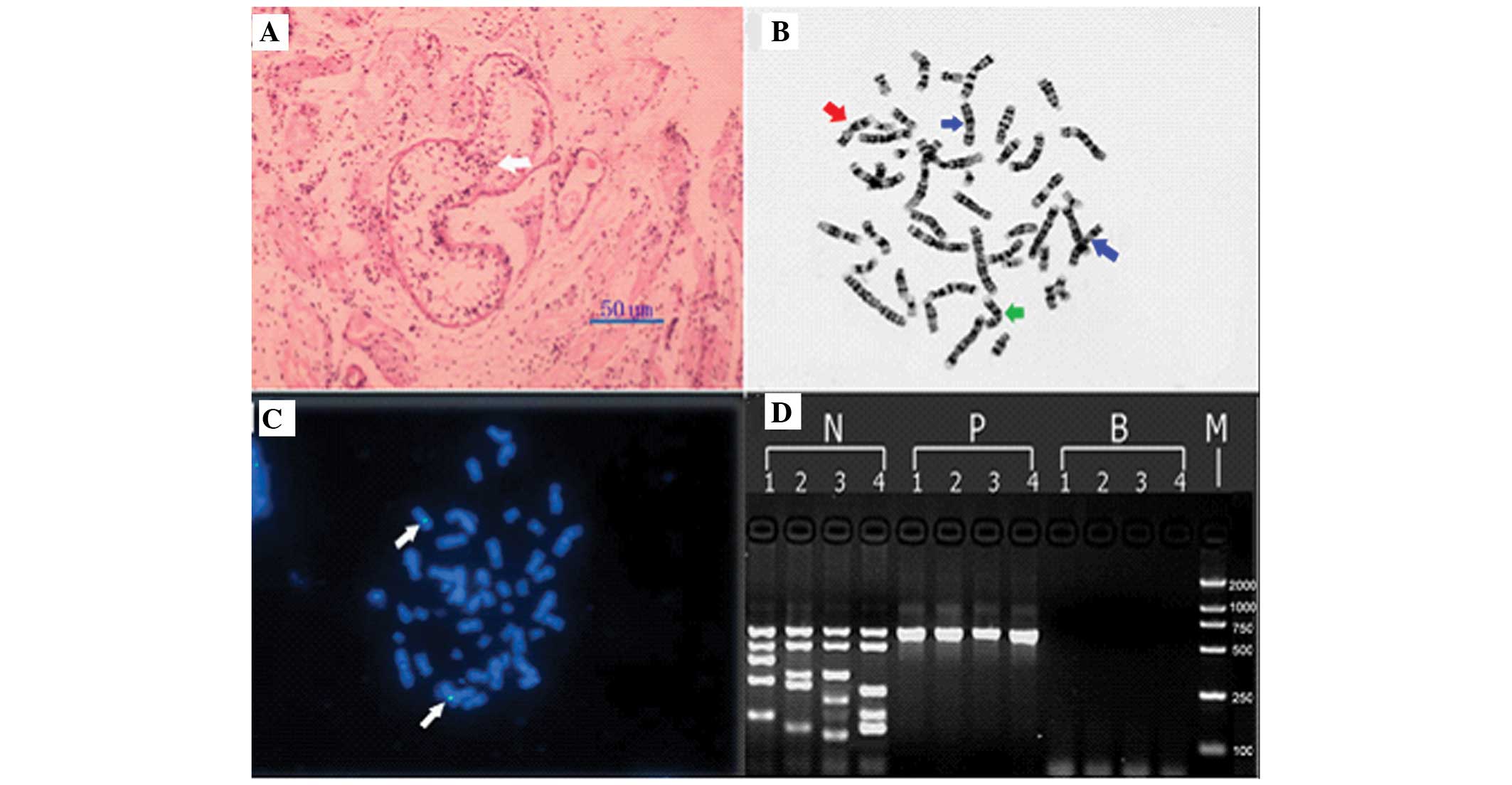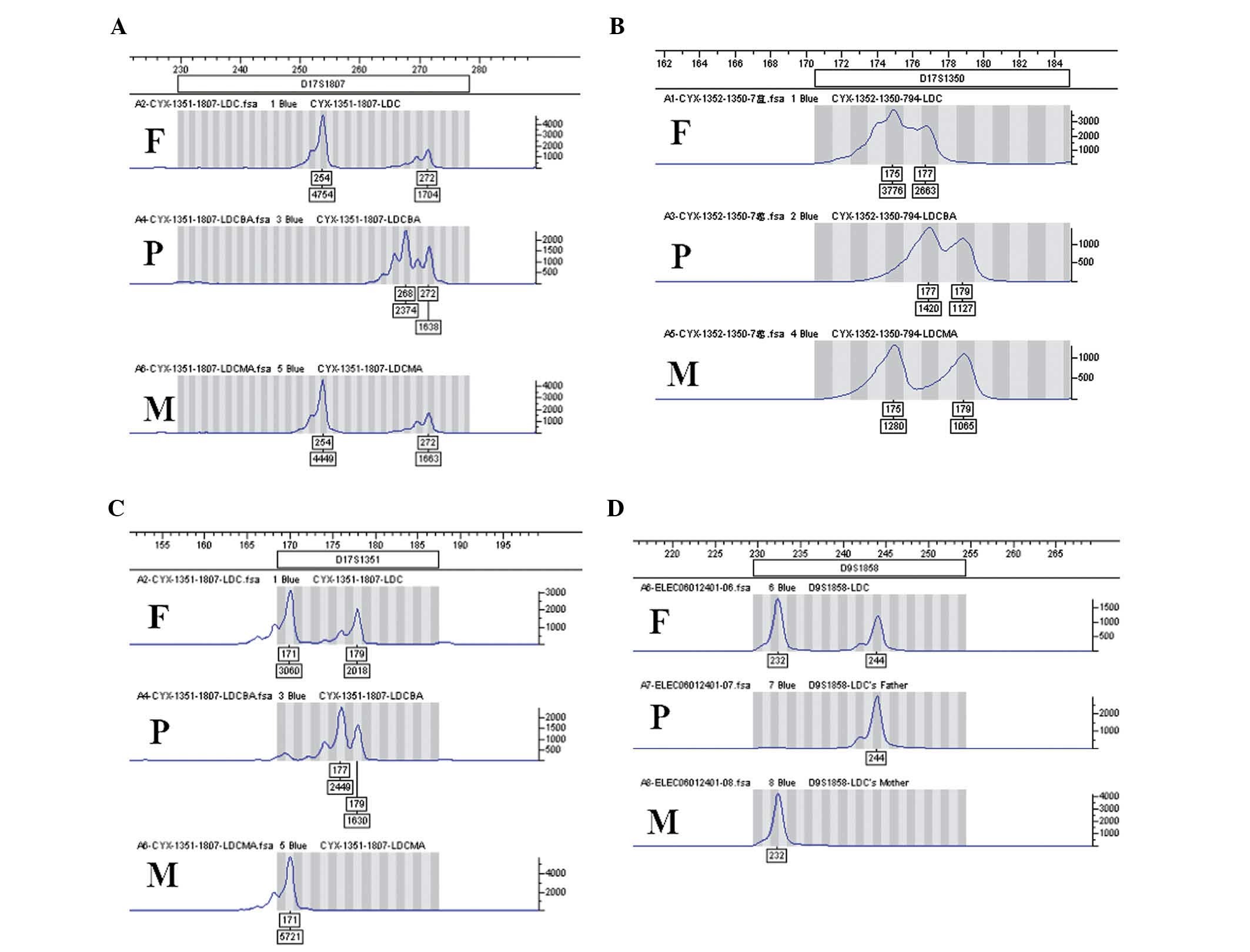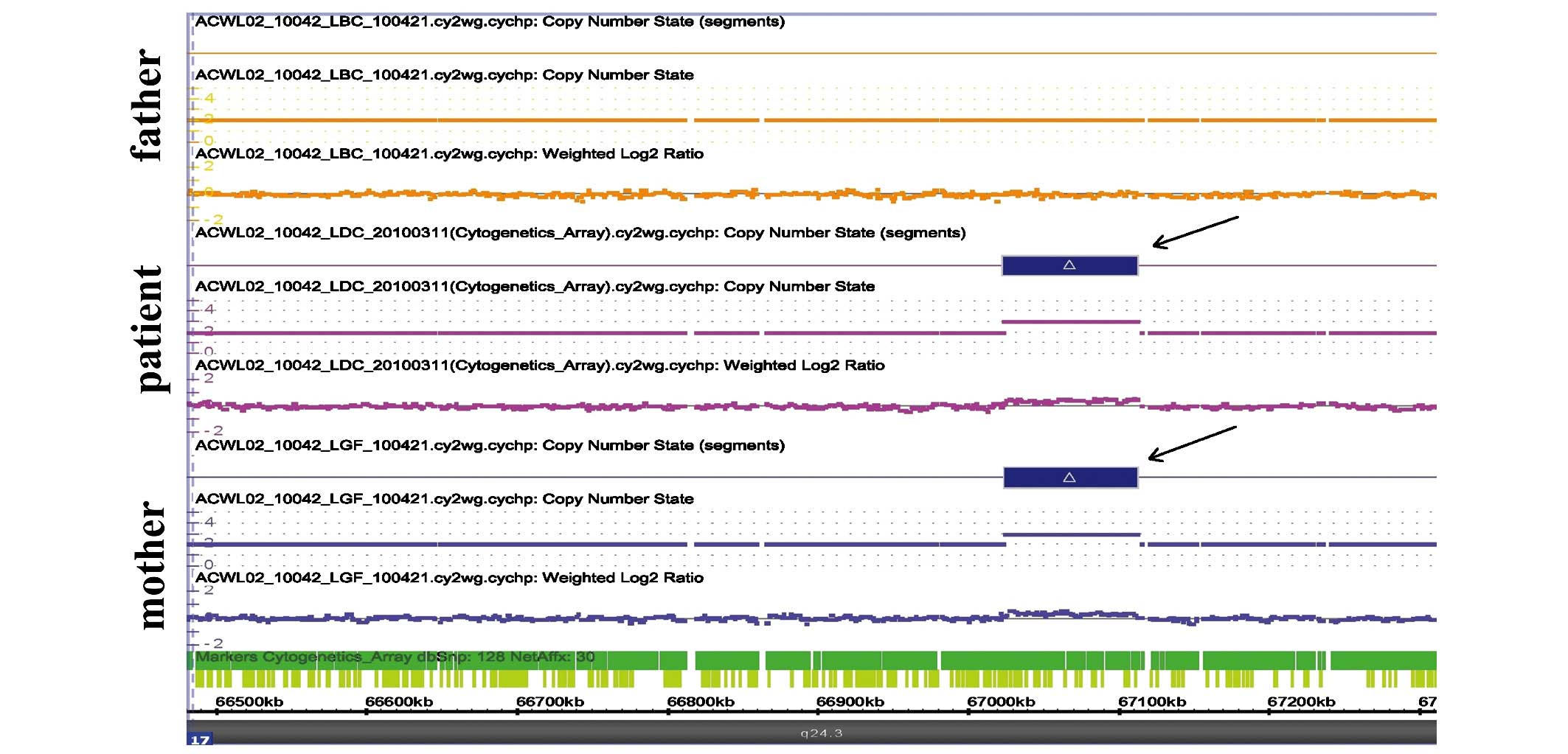|
1
|
Xiao B, Ji X, Xing Y, Chen YW and Tao J: A
rare case of 46, XX SRY-negative male with approximately 74-kb
duplication in a region upstream of SOX9. Eur J Med Genet.
56:695–698. 2013. View Article : Google Scholar : PubMed/NCBI
|
|
2
|
Abbas NE, Toublanc JE, Boucekkine C,
Toublanc M, Affara NA, Job JC and Fellous M: A possible common
origin of 'Y-negative' human XX males and XX true hermaphrodites.
Hum Genet. 84:356–360. 1990. View Article : Google Scholar : PubMed/NCBI
|
|
3
|
Boucekkine C, Toublanc JE, Abbas N,
Chaabouni S, Ouahid S, Semrouni M, Jaubert F, Toublanc M,
McElreavey K and Vilain E: Clinical and anatomical spectrum in XX
sex reversed patients. Relationship to the presence of Y specific
DNA-sequences. Clin Endocrinol (Oxf). 40:733–742. 1994. View Article : Google Scholar
|
|
4
|
McElreavey K, Rappaport R, Vilain E, Abbas
N, Richaud F, Lortat-Jacob S, Berger R, Le Coniat M, Boucekkine C
and Kucheria K: A minority of 46, XX true hermaphrodites are
positive for the Y-DNA sequence including SRY. Hum Genet.
90:121–125. 1992. View Article : Google Scholar : PubMed/NCBI
|
|
5
|
Ferguson-Smith MA, Cooke A, Affara NA,
Boyd E and Tolmie JL: Genotype-phenotype correlations in XX males
and their bearing on current theories of sex determination. Hum
Genet. 84:198–202. 1990. View Article : Google Scholar : PubMed/NCBI
|
|
6
|
Ergun-Longmire B, Vinci G, Alonso L,
Matthew S, Tansil S, Lin-Su K, McElreavey K and New MI: Clinical,
hormonal and cytogenetic evaluation of 46,XX males and review of
the literature. J Clin Endocrinol Metab. 18:739–748. 2005.
|
|
7
|
Vorona E, Zitzmann M, Gromoll J, Schuring
AN and Nieschlag E: Clinical, endocrinological, and epigenetic
features of the 46,XX male syndrome, compared with 47,XXY
Klinefelter patients. J Clin Endocrinol Metab. 92:3458–3465. 2007.
View Article : Google Scholar : PubMed/NCBI
|
|
8
|
Brennan J and Capel B: One tissue, two
fates: Molecular genetic events that underlie testis versus ovary
development. Nat Rev Genet. 5:509–521. 2004. View Article : Google Scholar : PubMed/NCBI
|
|
9
|
Meeks JJ, Weiss J and Jameson JL: Dax1 is
required for testis determination. Nat Genet. 34:32–33. 2003.
View Article : Google Scholar : PubMed/NCBI
|
|
10
|
Sutton E, Hughes J, White S, Sekido R, Tan
J, Arboleda V, Rogers N, Knower K, Rowley L, Eyre H, et al:
Identification of SOX3 as an XX male sex reversal gene in mice and
humans. J Clin Invest. 121:328–341. 2011. View Article : Google Scholar :
|
|
11
|
Parma P, Radi O, Vidal V, Chaboissier MC,
Dellambra E, Valentini S, Guerra L, Schedl A and Camerino G:
R-spondin1 is essential in sex determination, skin differentiation
and malignancy. Nat Genet. 38:1304–1309. 2006. View Article : Google Scholar : PubMed/NCBI
|
|
12
|
Chi L, Itäranta P, Zhang S and Vainio S:
Sprouty2 is involved in male sex organogenesis by controlling
fibroblast growth factor 9-induced mesonephric cell migration to
the developing testis. Endocrinology. 147:3777–3788. 2006.
View Article : Google Scholar : PubMed/NCBI
|
|
13
|
Chiang HS, Wu YN, Wu CC and Hwang JL:
Cytogenic and molecular analyses of 46, XX male syndrome with
clinical comparison to other groups with testicular azoospermia of
genetic origin. J Formos Med Assoc. 112:72–78. 2013. View Article : Google Scholar : PubMed/NCBI
|
|
14
|
Mizuno K, Kojima Y, Kamisawa H, Moritoki
Y, Nishio H, Kohri K and Hayashi Y: Gene expression profile during
testicular development in patients with SRY-negative 46,XX
testicular disorder of sex development. Urology. 82:1453.e1–e7.
2013. View Article : Google Scholar
|
|
15
|
Smith CA, McClive PJ, Western PS, Reed KJ
and Sinclair AH: Evolution: Conservation of a sex-determining gene.
Nature. 402:601–602. 1999. View
Article : Google Scholar : PubMed/NCBI
|
|
16
|
Shan Z, Zabel B, Trautmann U, Hillig U,
Ottolenghi C, Wang Y and Haaf T: FISH mapping of the sex-reversal
region on human chromosome 9p in two XY females and in primates.
Eur J Hum Genet. 8:167–173. 2000. View Article : Google Scholar : PubMed/NCBI
|
|
17
|
Seeherunvong T, Perera EM, Bao Y, Benke
PJ, Benigno A, Donahue RP and Berkovitz GD: 46, XX sex reversal
with partial duplication of chromosome arm 22q. Am J Med Genet A.
127:149–151. 2004. View Article : Google Scholar
|
|
18
|
Huang B, Wang S, Ning Y, Lamb AN and
Bartley J: Autosomal XX sex reversal caused by duplication of SOX9.
Am J Med Genet. 87:349–353. 1999. View Article : Google Scholar : PubMed/NCBI
|
|
19
|
Bishop CE, Whitworth DJ, Qin Y, Agoulnik
AI, Agoulnik IU, Harrison WR, Behringer RR and Overbeek PA: A
transgenic insertion upstream of sox9 is associated with dominant
XX sex reversal in the mouse. Nat Genet. 26:490–494. 2000.
View Article : Google Scholar : PubMed/NCBI
|
|
20
|
Vidal VP, Chaboissier MC, de Rooij DG and
Schedl A: Sox9 induces testis development in XX transgenic mice.
Nat Genet. 28:216–217. 2001. View
Article : Google Scholar : PubMed/NCBI
|
|
21
|
Cox JJ, Willatt L, Homfray T and Woods CG:
A SOX9 duplication and familial 46, XX developmental testicular
disorder. N Engl J Med. 364:91–93. 2011. View Article : Google Scholar : PubMed/NCBI
|
|
22
|
Vetro A, Ciccone R, Giorda R, Patricelli
MG, Della Mina E, Forlino A and Zuffardi O: XX males SRY negative:
A confirmed cause of infertility. J Med Genet. 48:710–712. 2011.
View Article : Google Scholar : PubMed/NCBI
|
|
23
|
Benko S, Gordon CT, Mallet D, Sreenivasan
R, Thauvin-Robinet C, Brendehaug A, Thomas S, Bruland O, David M,
Nicolino M, et al: Disruption of a long distance regulatory region
upstream of SOX9 in isolated disorders of sex development. J Med
Genet. 48:825–830. 2011. View Article : Google Scholar : PubMed/NCBI
|
|
24
|
de la Chapelle A: The etiology of maleness
in XX men. Hum Genet. 58:105–116. 1981. View Article : Google Scholar : PubMed/NCBI
|
|
25
|
Wachtel SS: XX sex reversal in the human
Molecular genetics of sex determination. San Diego: Academic; pp.
2071994
|
|
26
|
Sinclair AH, Berta P, Palmer MS, Hawkins
JR, Griffiths BL, Smith MJ, Foster JW, Frischauf AM, Lovell-Badge R
and Goodfellow PN: A gene from the human sex-determining region
encodes a protein with homology to a conserved DNA-binding motif.
Nature. 346:240–244. 1990. View Article : Google Scholar : PubMed/NCBI
|
|
27
|
Koopman P, Gubbay J, Vivian N, Goodfellow
P and Lovell-Badge R: Male development of chromosomally female mice
transgenic for Sry. Nature. 351:117–121. 1991. View Article : Google Scholar : PubMed/NCBI
|
|
28
|
Brennan J and Capel B: One tissue, two
fates: Molecular genetic events that underlie testis versus ovary
development. Nat Rev Genet. 5:509–521. 2004. View Article : Google Scholar : PubMed/NCBI
|
|
29
|
Domenice S, Nishi MY, Billerbeck AE,
Carvalho FM, Frade EM, Latronico AC, Arnhold IJ and Mendonca BB:
Molecular analysis of SRY gene in Brazilian 46,XX sex reversed
patients: absence of SRY sequence in gonadal tissue. Med Sci Monit.
7:238–241. 2001.PubMed/NCBI
|
|
30
|
Ostrer H: Sex determination: Lessons from
families and embryos. Clin Genet. 59:207–215. 2001. View Article : Google Scholar : PubMed/NCBI
|
|
31
|
Sukumaran A, Desmangles JC, Gartner LA and
Buchlis J: Duplication of dosage sensitive sex reversal area in a
46, XY patient with normal sex determining region of Y causing
complete sex reversal. J Pediatr Endocrinol Metab. 26:775–779.
2013. View Article : Google Scholar : PubMed/NCBI
|
|
32
|
Qin Y, Kong LK, Poirier C, Truong C,
Overbeek PA and Bishop CE: Long-range activation of Sox9 in Odd Sex
(Ods) mice. Hum Mol Genet. 13:1213–1218. 2004. View Article : Google Scholar : PubMed/NCBI
|
|
33
|
Habert R, Lejeune H and Saez JM: Origin,
differentiation and regulation of fetal and adult Leydig cells. Mol
Cell Endocrinol. 179:47–74. 2001. View Article : Google Scholar : PubMed/NCBI
|
|
34
|
Gordon CT, Tan TY, Benko S, Fitzpatrick D,
Lyonnet S and Farlie PG: Long-range regulation at the SOX9 locus in
development and disease. J Med Genet. 46:649–656. 2009. View Article : Google Scholar : PubMed/NCBI
|

















